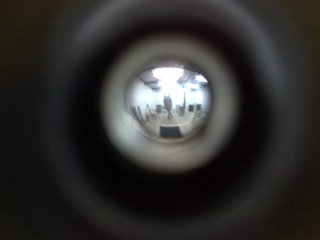A Short Guide to Contemporary Art in Ukraine (“Short Guide Series”)
ARTMargins begins a series of concise introductions to the developing art scenes of East-Central Europe.
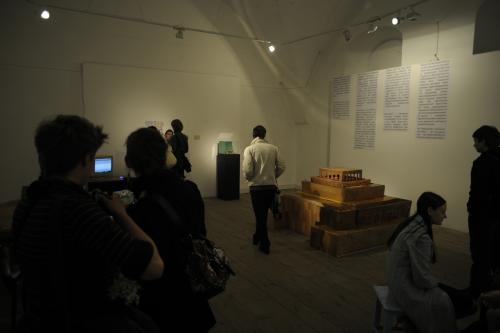 Last May an exhibition titled Pohlyady (Views) that highlighted the confluence of art and politics was organized by HudRada (Arts Council) at the Center for Contemporary Art in Kyiv. HudRada is a group of Ukrainian artists, architects, translators and political activists; many members of the Ukrainian contemporary art community participate in its internet-based discourse. HudRada has wide-ranging aims, which include self-education through communication as well as creating exhibitions and other consciousness-raising events. Without the hierarchical management of a single curator, the members of HudRada collaborated on the development of Pohlyady mostly through email correspondence. Poster-size text excerpts from their discussions hung on the gallery walls amongst the artworks. Lectures, roundtables and guided tours enhanced the visitors’ experience, adding an interpretive dimension and creating a setting for those interested in Ukrainian contemporary art to meet and exchange ideas. By encouraging critical discourse, the group is working to slowly transform the Ukrainian art scene.
Last May an exhibition titled Pohlyady (Views) that highlighted the confluence of art and politics was organized by HudRada (Arts Council) at the Center for Contemporary Art in Kyiv. HudRada is a group of Ukrainian artists, architects, translators and political activists; many members of the Ukrainian contemporary art community participate in its internet-based discourse. HudRada has wide-ranging aims, which include self-education through communication as well as creating exhibitions and other consciousness-raising events. Without the hierarchical management of a single curator, the members of HudRada collaborated on the development of Pohlyady mostly through email correspondence. Poster-size text excerpts from their discussions hung on the gallery walls amongst the artworks. Lectures, roundtables and guided tours enhanced the visitors’ experience, adding an interpretive dimension and creating a setting for those interested in Ukrainian contemporary art to meet and exchange ideas. By encouraging critical discourse, the group is working to slowly transform the Ukrainian art scene.
While HudRada reflects the international trend toward incorporating communication into art practice, it is also the contemporary manifestation of a long-standing Ukrainian tradition of collective thinking and action. In Soviet times, an official institution also called HudRada ensured the dissemination of national ideology through artistic practice. The new HudRada promotes political activism and left-wing ideals, in opposition to the current Ukrainian tendency to favor the commercial and decorative value of art. The organization’s Yevgeniya Belorusets, a writer and activist, explains: “The fundamental platform uniting the group involves communication, discussion, the search for some kind of aesthetic expression that is appropriately politically engaged.”(<http://www.prostory.net.ua/ua/art/7-art/204>.) Like their Soviet predecessors, the organizers of Pohlyady see art as inseparable from society and believe in its potential to act on the Ukrainian socio-political imagination.
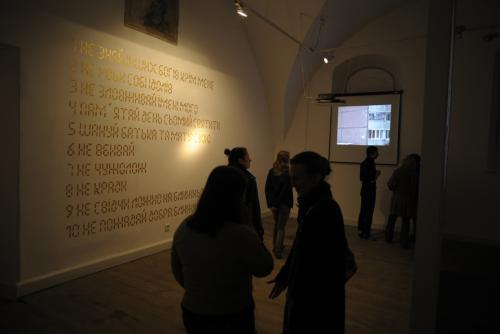 Pohlyady received a lot of attention both informally and in the Ukrainian press (especially in left-wing and arts publications), despite the middling quality of its conceptual design and of individual works. This points to several common characteristics of the Ukrainian contemporary art scene. First, many of the members of the curatorial team work as journalists, editors or art critics and are also political activists; their involvement in such diverse activities affects the choices they made in developing the exhibition, as well as their objective assessment of it. The small Ukrainian art world is just starting to simmer with activity, so any provocative happening draws interest from a growing circle of curious people. To accommodate an audience with varied levels of familiarity with contemporary art, education and communication were also significant components of the exhibition. Finally, the fact that Pohlyady was generated by a grass-roots organization mostly outside of institutional bounds demonstrates HudRada’s critical position within the existing institutions of Ukrainian contemporary art.
Pohlyady received a lot of attention both informally and in the Ukrainian press (especially in left-wing and arts publications), despite the middling quality of its conceptual design and of individual works. This points to several common characteristics of the Ukrainian contemporary art scene. First, many of the members of the curatorial team work as journalists, editors or art critics and are also political activists; their involvement in such diverse activities affects the choices they made in developing the exhibition, as well as their objective assessment of it. The small Ukrainian art world is just starting to simmer with activity, so any provocative happening draws interest from a growing circle of curious people. To accommodate an audience with varied levels of familiarity with contemporary art, education and communication were also significant components of the exhibition. Finally, the fact that Pohlyady was generated by a grass-roots organization mostly outside of institutional bounds demonstrates HudRada’s critical position within the existing institutions of Ukrainian contemporary art.
Contemporary art arrived in Ukraine as an imported concept. Young Ukrainian artists generally receive very traditional training that does not incorporate current art world trends. Most of the Ukrainian public has little experience viewing contemporary art and lacks the background knowledge needed to contextualize certain pieces. Art-related education and communication have become invaluable practices both for artists trying to broaden their knowledge and for cultivating the potential audience for new artwork, as well as a way to invigorate local art practices still heavily influenced by formal academicism. By acquainting local art practitioners and viewers with the history, international tendencies, theories and practices of contemporary art, members of the Ukrainian arts community are building upthe local context for contemporary art.
Institutional support of contemporary art in Ukraine began in the 1990s but has grown significantly in the last five years. The institutions have varied in scale from the Soros-funded Center for Contemporary Art in Kyiv (another existed in Odessa from 1996-2000) to the PinchukArtCentre, which opened its prominent gallery in the center of Kyiv in 2006. Each of them is backed by a wealthy sponsor whose expertise lies in investment and philanthropy rather than art. However, these institutions have played an important role in educating young artists and choosing which works will be presented to the Ukrainian public under the rubric “contemporary art.”
The Center for Contemporary Art (CCA), which hosted HudRada’s exhibition Pohlyady, was one of the first institutions to introduce contemporary art practice to Ukraine. Originally funded by George Soros between 1993 and 1999 (as part of his program of Soros Centers for Contemporary Art in many Eastern European and post-Soviet countries), the CCA was a hub of exchange, bringing exhibitions of works of major contemporary art figures – such as Joseph Kosuth and Ilya Kabakov in 1999, or Andy Warhol in 2000 – to Ukraine, as well as supporting the development of local artists through grants and exhibitions. After 1999, the CCA became an independent institution and gradually lost the financial support of Soros. In recent years, amidst financial struggles, it served as a laboratory for nurturing the younger generation of Ukrainian artists. In December 2008, it officially closed its gallery space and took on the new name Foundation Center for Contemporary Art. However, it still functions as an archive and continues to support education and outreach programs, often in partnership with other organizations. The CCA’s most recent efforts include inviting guests – like Polish artist Katarzyna Kozyra – to sustain communication between the Ukrainian art community and its Eastern European context, as well as organizing art management workshops in regional centers of Ukraine.
The EIDOS Arts Development Foundation [www.eidosfund.org], established in 2005 by Dr. Ludmila Bereznitsky, Lubov Michailova and Petro Bagriy, has made a priority of using art education and communication to cultivate the Ukrainian contemporary art community. Their regular events bring together artists, curators, critics, writers and students, with the intent of fostering connections between isolated groups (the so-called tusovkas). Such events not only supplement the limited art education available at the National Academy, but they also serve as a catalyst for forming relationships which may lead to further cooperation. In 2008, the foundation invited a series of international curators and artists – Yara Bubnova, Roger M. Buergel, Martin Keil and Ekaterina Dyogot – who are known for work that critically investigates the intersection of art and society to Kyiv to share their expertise with the local community. The EIDOS Foundation also sponsored a grant competition for art projects in public space. The foundation’s activities, which often address the dialogue between contemporary art and its social context, help Ukrainian artists cultivate the professional skills necessary for further contact with international arts institutions and for realizing their projects.
Recently, the EIDOS Arts Development Foundation and Ludmila Bereznitsky and Partner Gallery opened a new, sleek space for contemporary art in Kyiv – the EIDOS Contemporary Art Centre. The CAC plans to showcase both experimental work by young Ukrainian artists and international curatorial projects. The first show presented works by SOSka, a collective of young artists from Kharkiv, whose works often deal with local social or political issues. EIDOS Foundation President Ludmila Bereznitsky(Ludmila Bereznitsky is also the director of Bereznitsky Gallery in Berlin which represents Ukrainian contemporary art.) said that the “CAC aims to become a communication platform to develop the arts situation in Ukraine,” and so it will host educational programs sponsored by the EIDOS Foundation.(<http://www.eidosfund.org/eng/news/read/688/>.) The CAC also promotes Ukrainian new media and video art, which are seldom exhibited in private galleries partial to traditional media such as painting.
Since its opening in 2006, the PinchukArtCentre (PAC) [http://pinchukartcentre.org], which is independently supported by billionaire collector Viktor Pinchuk, has dominated the public perception of contemporary art with its large gallery space in Kyiv. Through unparalleled financial resources for exhibiting art in Ukraine, the institution has succeeded in making contemporary art accessible to a wide Ukrainian and international public. With free admission, convenient visiting hours and extensive PR, the museum welcomes tens of thousands of visitors to each of its major exhibitions (about three per year). The most recent show, “Requiem,” is Damien Hirst’s biggest retrospective to date and includes the exclusive world premiere of works from his recent series “Skull Paintings.” Hirst visited Kyiv for the opening, and also donated medical equipment to a children’s hospital in a joint charitable venture with the Victor Pinchuk Foundation.
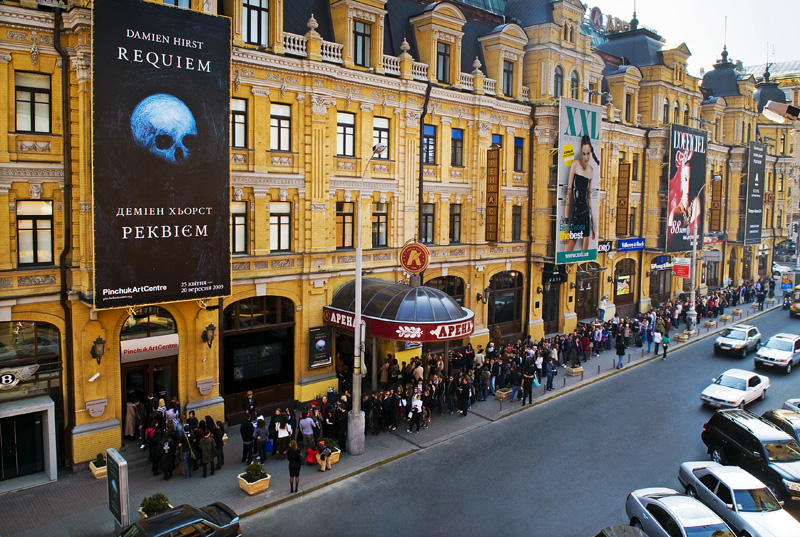 Because the PAC is the only institution of its kind, scale and visibility, many Ukrainian visitors formulate their idea of contemporary art based solely on what they see there. Pinchuk’s collection, which includes works by Andreas Gursky, Jeff Koons and Damien Hirst, emphasizes artists with celebrity status and work that is expensive and spectacular. In Ukraine, radio news stories rate the most expensive contemporary artists, so there is a tendency to view art as a luxury item in the hands of the elite but on display to the public, not unlike other flashy commodities like the Bentley sedans in the showroom next door to the PAC.
Because the PAC is the only institution of its kind, scale and visibility, many Ukrainian visitors formulate their idea of contemporary art based solely on what they see there. Pinchuk’s collection, which includes works by Andreas Gursky, Jeff Koons and Damien Hirst, emphasizes artists with celebrity status and work that is expensive and spectacular. In Ukraine, radio news stories rate the most expensive contemporary artists, so there is a tendency to view art as a luxury item in the hands of the elite but on display to the public, not unlike other flashy commodities like the Bentley sedans in the showroom next door to the PAC.
In an essay called “Abandoned Agent,” artist Nikita Kadan observed that the contemporary art scene in Ukraine since the 1990s has been dominated by a series of businessmen, like Soros and Pinchuk, with their own personal, peripheral interests. Artists would gravitate toward whichever institution was dominant at the time, and the art shown by that institution – often reflecting a particular aesthetic or political bias – would define “contemporary art in Ukraine” at that given moment. Today the three above-mentioned institutions operate simultaneously, albeit with a wide variation in resources and visibility. Each supports a particular aspect of the Ukrainian art scene, from the CCA’s laboratory setting to EIDOS’s cheering of art that engages with society to the PAC’s flaunting of affluence. However, local artists drift from one institution to another, in addition to forming their own alternative organizations and seeking support from private galleries.
Only a few private galleries in Ukraine show contemporary art and artists. Karas Gallery [www.karasgallery.com] in Kyiv (run by Yevhen Karas since 1995) and Dzyga [www.dzyga.com] in Lviv (established in 1993) have built reputations in their respective local communities through ancillary practices like hosting performances at exhibition openings and organizing regional art festivals. In recent years, a few contemporary art galleries that reflect international professional business standards have opened in Kyiv. Collection Gallery [www.collectiongallery.com.ua] founded by Yuriy Kogutyak in 2006 works to build visitors’ facility for assessing contemporary art through regular talks by experts. Ya Gallery [www.yagallery.com.ua] was established in 2007 by Pavlo Gudimov and also hosts gatherings around artists’ talks and film screenings. However the majority of Ukrainian gallery owners and art buyers have limited expertise, so their tastes tend toward traditional media like painting and spectacular, entertaining artwork.
Earlier, art galleries were often registered as NGOs or located in artists’ studios and functioned without the pressure of market competition. Even today, few Ukrainian galleries direct their efforts to selling artists’ works locally or participate in international art fairs. It is still common for a gallery owner to demand that an artist donate one or two works in exchange for putting up an exhibition. Artists Ksenia Hnylytska and Nikita Kadan attest that buyers often try to circumvent the gallery altogether by going directly to the artist’s studio to bargain for a better price. Emerging Ukrainian artists express the need for an effective art market in Ukraine that would evaluate artworks by measures other than price and the artist’s celebrity status. They see potential benefits in educating buyers to refine their tastes toward art’s subtler values like criticality, questioning and experimentation.
As an alternative to privately sponsored contemporary art institutions and galleries, Ukrainian artists have set up their own spaces for gathering and sharing work, often incorporating education and communication practices as a form of resistance to the commercialized art market. LabGarage [http://labgarage.livejournal.com] is a new artist-run space established by artist-performer Artur Byelozyorov on the site of an already existing art cooperative in the center of Kyiv. The organizers invite artists of various disciplines (contemporary art, music, performance, film and literature) to create and display work in a gallery that is visible 24 hours a day through peepholes. LabGarage’s mission statement expresses an intention to bring art closer to society: “one of the gallery’s critical functions is to increase the number of artistic manifestations in the everyday life of the city and its citizens.” Activities include community service projects, like painting a mural on the exterior wall of a Kyiv psychiatric hospital. In addition to traditional visual/spatial forms like exhibitions and films, these artists are turning toward immaterial sites of interaction – events, gatherings, parties, etc. – to tap the potential of encounter for the creation of something new.
Kharkiv, a city of 1.5 million in eastern Ukraine without institutional resources for contemporary art, has a long tradition of artist-initiated spaces. In the mid-1990s artists Sergey Bratkov and Boris Mikhailov ran the Up/Down Gallery, which hosted exhibitions and performances by both local and Western European artists. In 2005, the art group SOSka (Mykola Ridnyi, Ganna Kriventsova, Serhiy Popov) established a laboratory-gallery squat for exhibiting contemporary art and other related projects. In May 2008, in cooperation with the Kharkiv Municipal Art Gallery, they organized a series of talks by the Kyiv-based artist-group R.E.P., and David Ter-Oganyan and Sasha Galkina from Moscow. The event attracted many local art students, some of whom then took part in SOSka’s laboratory for emerging artists “Class.” Now that developers plan to demolish the building in which SOSka was squatting, the artists are encouraging their young colleagues to continue the Kharkiv tradition and find their own space.
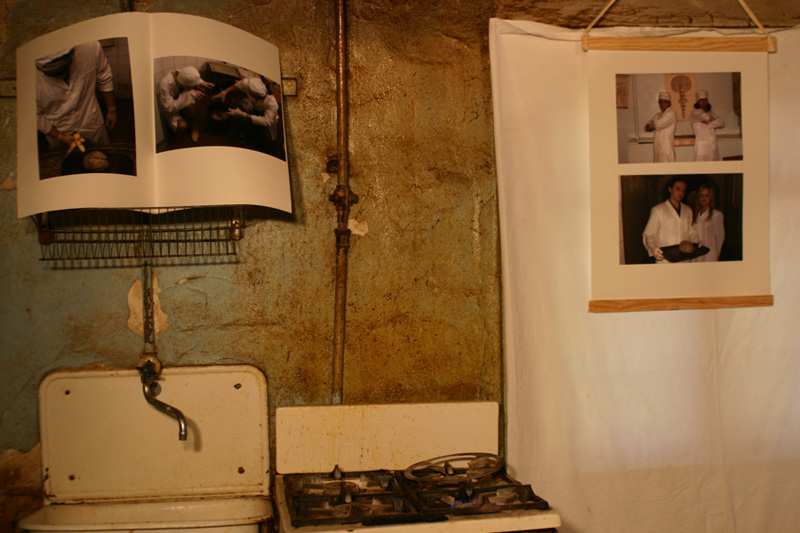 With the scarcity of affordable real estate in Ukraine, virtual space has become a valuable meeting place for creative and critical minds. The past few years have seen the launch of new websites devoted to critical writings on contemporary art and how it relates to the Ukrainian context. In addition to the multi-functional HudRada discussion group, the EIDOS Foundation maintains ARTFORUMWEB [www.lib.eidosfund.org], an Internet portal for critical essays, reviews, discussions and information about local artists. Durchschlag [http://durchschlag.ho.ua] is a Ukrainian art e-zine established in 2007. Like HudRada, it is a collective venture in which the editorial board invites contributions from all interested parties and manages the compilation of each issue as a group, playing down the role of individual authority. KrAM (Criticism of Actual Art) [http://kram.in.ua/useless_reading/] was founded in 2008 by six individuals(The founding members of KrAM are: Volodymyr Babyuk, art consumer; Kateryna Botanova, art manager; Alevtina Kakhidze, artist; Taras Lyuty, philosopher; Olesya Ostrovska, curator; and Yuliya Vaganova, art manager.) concerned with the inadequate level of art criticism in Ukraine. The project has no outside sponsors and publishes texts by the founding members or invited guests, which reflect the local context. In a different vein, the online newspaper ZOMBIE [www.zombie.ccc- k.net], edited by Nikita Kadan, Inga Zimprich and Sönke Hallmann, assembles texts on the practice of art and theory that cut across national boundaries in a multi-lingual discourse. While each of these projects aims to expand the breadth and activity of critical discussion in the Ukrainian contemporary art sphere, the number of participating voices is limited. There is a danger that a few monopolizing individual views will encumber the free circulation of ideas; but on the other hand, the echo of the same voices from one project to another is a sign of the formation of a community.
With the scarcity of affordable real estate in Ukraine, virtual space has become a valuable meeting place for creative and critical minds. The past few years have seen the launch of new websites devoted to critical writings on contemporary art and how it relates to the Ukrainian context. In addition to the multi-functional HudRada discussion group, the EIDOS Foundation maintains ARTFORUMWEB [www.lib.eidosfund.org], an Internet portal for critical essays, reviews, discussions and information about local artists. Durchschlag [http://durchschlag.ho.ua] is a Ukrainian art e-zine established in 2007. Like HudRada, it is a collective venture in which the editorial board invites contributions from all interested parties and manages the compilation of each issue as a group, playing down the role of individual authority. KrAM (Criticism of Actual Art) [http://kram.in.ua/useless_reading/] was founded in 2008 by six individuals(The founding members of KrAM are: Volodymyr Babyuk, art consumer; Kateryna Botanova, art manager; Alevtina Kakhidze, artist; Taras Lyuty, philosopher; Olesya Ostrovska, curator; and Yuliya Vaganova, art manager.) concerned with the inadequate level of art criticism in Ukraine. The project has no outside sponsors and publishes texts by the founding members or invited guests, which reflect the local context. In a different vein, the online newspaper ZOMBIE [www.zombie.ccc- k.net], edited by Nikita Kadan, Inga Zimprich and Sönke Hallmann, assembles texts on the practice of art and theory that cut across national boundaries in a multi-lingual discourse. While each of these projects aims to expand the breadth and activity of critical discussion in the Ukrainian contemporary art sphere, the number of participating voices is limited. There is a danger that a few monopolizing individual views will encumber the free circulation of ideas; but on the other hand, the echo of the same voices from one project to another is a sign of the formation of a community.
R.E.P. (Revolutionary Experimental Space) is group of young Ukrainian artists that has achieved local and international acclaim for their active role in shaping and critiquing the Ukrainian contemporary art scene. In addition to working collaboratively, they often feature communication as a central theme in their projects. In “Patriotism,” begun in 2006, the artists conceived an “artificial visual language” to express concepts in an internationally accessible way. In each installation, they composed their graphic symbols into new images, whose meaning could be deciphered with the help of an accompanying “dictionary.” The project, which was shown in Ukraine and in various European venues, makes an attempt at creating a universal language that could transcend national, cultural and institutional boundaries.
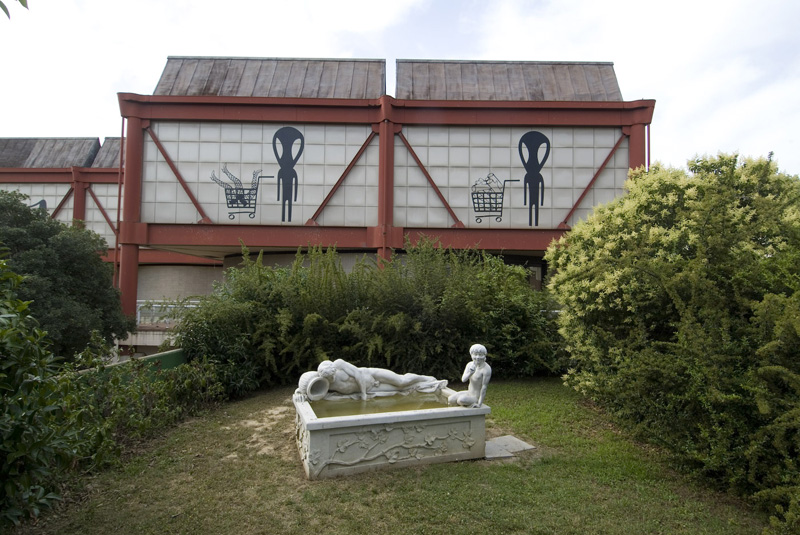 R.E.P. was established in 2004 amidstthe events of Ukraine’s Orange Revolution, and social-political activism remains central to their practice. Their projects take many forms, including organizing critical discussions and curating exhibitions. In 2007, R.E.P. drew attention to the trend among Ukraine’s emerging artists to work collaboratively through an exhibition called “Communities Project” at the CCA in Kyiv. Artist Nikita Kadan, one of R.E.P.’s founding members, explains that one reason that young Ukrainian artists – often called “Generation 2004” – are drawn to the structure of the collective comes from the experience of the Orange Revolution, where autonomous, self-organized groups assembled to stand up for common principles against established authority.
R.E.P. was established in 2004 amidstthe events of Ukraine’s Orange Revolution, and social-political activism remains central to their practice. Their projects take many forms, including organizing critical discussions and curating exhibitions. In 2007, R.E.P. drew attention to the trend among Ukraine’s emerging artists to work collaboratively through an exhibition called “Communities Project” at the CCA in Kyiv. Artist Nikita Kadan, one of R.E.P.’s founding members, explains that one reason that young Ukrainian artists – often called “Generation 2004” – are drawn to the structure of the collective comes from the experience of the Orange Revolution, where autonomous, self-organized groups assembled to stand up for common principles against established authority.
According to Kadan, artistic cooperation is also a critical reaction to the earlier 1990s generation, who took advantage of the chaos and fragmentation of wild capitalism to build their artistic careers. Many critical Ukrainian artists of the 1990s – Sergey Bratkov, Boris Mikhailov, Oleg Kulik, to name a few – emigrated to countries such as Russia, Germany and the United States and are now successful in the international art world and market. Some still admit to their Ukrainian roots, while others identify with their countries of residence. The new generation looks further back to collective traditions of Soviet times, like the official Society of Artists and the Academy of Art, and also to underground anarchist groups. Rather than disowning this history, today’s Ukrainian artists have chosen to develop the collective form and adapt it to their current situation.
Another collaborative artistic venture, “Carpathian Theatre,” founded by Ukrainian-born artist Ivan Bazak, was also featured in the “Communities Project” exhibition. Its members include artists and other professionals from Ukraine and other countries. Their projects span various media and locales in Germany and Ukraine. Bazak, based in Germany since 2001, often addresses Ukrainian social issues like labor migration in his artwork. His projects, which reach an international audience, combine a global worldview with detailed attention to local context. Bazak is concerned with bringing contemporary art to his native Western Ukraine through projects like the Carpathian Biennale. This multi-venue site-specific event premiered in Cologne last spring and will continue in Lviv and Carpathian Mountain villages later this year.
Alevtina Kakhidze is unique among her fellow Ukrainian artists because most of her projects are realized independently of a collective group structure. Kakhidze was educated in Ukraine and the Netherlands. Like Bazak, in her artistic practice she examines local issues (like Ukrainian notions of public and private through the architecture of balconies and fences) from a perspective that reflects her international experience. Her contribution to the developing Ukrainian contemporary art scene is the establishment of an artist’s residency program with her husband on their property outside of Kyiv. While many young Ukrainian artists strive to establish themselves abroad, Kakhidze is inviting artists from other countries to explore Ukraine.
Because of the small scale of the Ukrainian contemporary art community, there is often a fine line between the institutions who support the creation of contemporary art and those who take a critical position toward them. By controlling the selection process through which artists and projects get grants, exhibition space, resources and support, Ukraine’s few contemporary art institutions can exude great influence over the development of Ukrainian contemporary art, steering it in the direction of their particular interests. Following Soviet and post-Soviet tradition, this system is still not fully transparent, sometimes favoring personal connections over objective merit.
When local, self-organized artists’ initiatives encounter established art institutions there is potential for conflict. Over the last year, SOSka developed a contemporary art exhibition for the Kharkiv Art Museum to be installed temporarily alongside its permanent collection. The five-day exhibition was designed to rejuvenate the museum’s old, traditional artworks through juxtaposition with critical contemporary artworks. With outside financial support from the EIDOS Foundation, neither the artists-curators nor the host museum would incur any extra costs. After months of negotiations and planning between members of the SOSka curatorial team and the museum’s assistant director, the works were installed. Half an hour before the exhibition opened, museum director Valentina Myzgina entered the galleries in a rage, demanding that one installation be removed and that other video works be rearranged. The following day, before the start of a special guided tour for local students, the director closed the exhibition without further explanation. TS sexii trina videos
In a country where official art institutions (museums and art academies) are stubbornly focused on maintaining the status quo without any interest in exploring new ways of experiencing and thinking about art, the self-organized artistic community acts as an alternative, parallel structure of support. Yet there is ambivalence in the roles that many individuals play in this small, close-knit community. Members of R.E.P. and other artistic groups often work simultaneously as artists, curators and critics, so the threshold between the makers, supporters and evaluators blurs into a collective of mutual support and discussion. In projects like HudRada, which endeavor to stimulate critical thinking through communication and self-organized education, the views and voices of creators and commentators-critics belong to the same people. There are few art experts in the Ukrainian community, so critical reviews of local projects are often written by the participants-artists themselves or their close friends or colleagues. But how can one maintain critical distance, create good work without some separation from the group, without competition amongst its members?
It is not particularly surprising that in the Ukrainian contemporary art community, the boundaries between artists, critics, and supporting institutions are never very clearly drawn. This society has a long history of working collectively, and of corruption. The particular interest in the social function of art has roots in Soviet tradition, but has practical application today for establishing a wider audience for contemporary art. The few institutions and artistic groups that dominate the Ukrainian contemporary art scene are concerned with the local and international art market, educational outreach and communication practices. The visibility of their activities affects the way the Ukrainian public as well as international audiences view Ukrainian contemporary art.
For related texts, please see A Short Guide to Contemporary Art in Slovenia (“Short Guide Series”) (Article).


